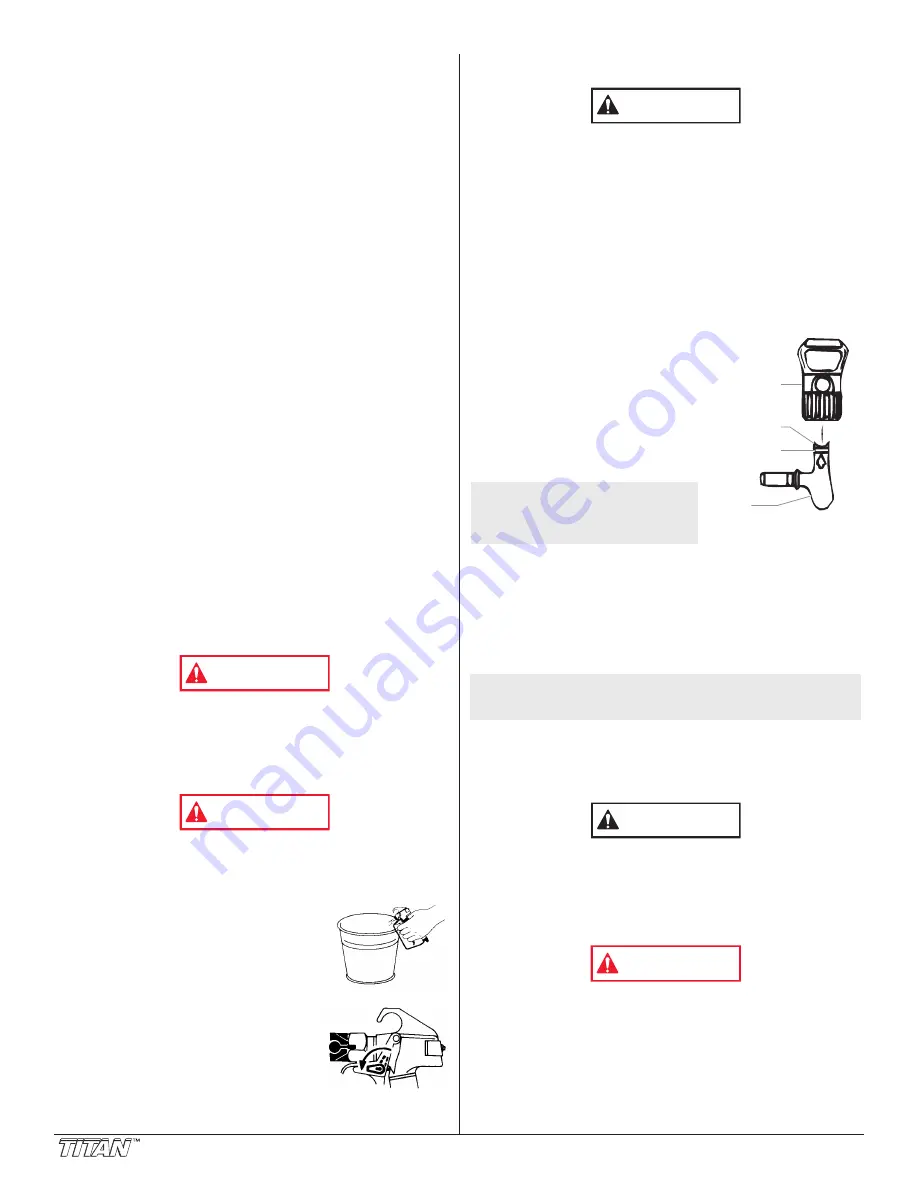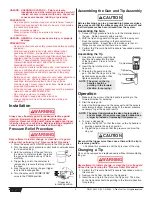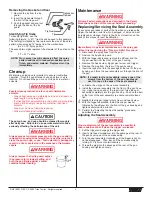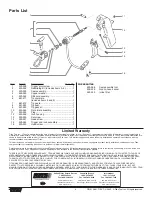
2
P/N 313-001, REV C © 2002 © Titan Tool Inc. All rights reserved.
HAZARD: HAZARDOUS VAPORS - Paints, solvents,
insecticides, and other materials can be harmful if
inhaled or come in contact with body. Vapors can
cause severe nausea, fainting, or poisoning.
PREVENTION:
• Use a respirator or mask if vapors can be inhaled. Read all
instructions supplied with the mask to be sure it will provide
the necessary protection.
• Wear protective eyewear.
• Wear protective clothing as required by coating
manufacturer.
HAZARD: GENERAL - Can cause severe injury or property
damage.
PREVENTION:
• Read all instructions and safety precautions before operating
equipment.
• Follow all appropriate local, state, and national codes
governing ventilation, fire prevention, and operation.
• The United States Government Safety Standards have been
adopted under the Occupational Safety and Health Act
(OSHA). These standards, particularly part 1910 of the
General Standards and part 1926 of the Construction
Standards should be consulted.
• Use only manufacturer authorized parts. User assumes all
risks and liabilities when using parts that do not meet the
minimum specifications and safety devices of the pump
manufacturer.
• Before each use, check all hoses for cuts, leaks, abrasion or
bulging of cover. Check for damage or movement of
couplings. Immediately replace hose if any of those
conditions exist. Never repair a paint hose. Replace with a
grounded high-pressure hose.
• All hoses, swivels, guns, and accessories must be pressure
rated at or above 5000PSI/350 BAR.
• Do not spray outdoors on windy days.
• Wear clothing to keep paint of skin and hair.
• Always unplug cord from the outlet before working on
equipment.
Installation
Always use a tip safety guard for added protection against
injection. Beware that the guard alone will not prevent
injection. Never cut off tip guard! Always engage gun trigger
lock when the gun is not in use. Before servicing equipment,
consult owner’s manuals and observe all warnings.
Pressure Relief Procedure
Never attempt to install, change, or clean tip or tip guard
without first performing the “Pressure Relief Procedure.”
1. Move the spray unit’s ON/OFF switch to the OFF position.
2. Turn the spray unit’s pressure control knob counterclockwise
to its lowest setting.
3. Hold the metal part of the gun firmly to
the side of a metal container to ground
the gun and avoid a build up of static
electricity.
4. Trigger the gun into the container to
remove any pressure that may still be in
the hose.
5. Lock the gun by turning the gun trigger
lock to the locked position.
6. Turn the spray unit’s PRIME/SPRAY
valve to the PRIME position.
Trigger lock
in locked position.
WARNING
WARNING
Assembling the Gun and Tip Assembly
Before attaching a gun to a grounded high pressure airless
hose, make sure that the airless spray unit is turned off and
that fluid pressure has been relieved from the system.
Assembling the Gun
1. Connect a high pressure fluid hose to the material inlet on
the gun. Tighten securely with a wrench.
2. With the tip and tip guard off the gun, start the spray unit.
Flush the system according to the manufacturer’s
recommendation. Inspect the unit to make sure that all
fittings are secure and that there are no leaks.
3. Perform the “Pressure Relief Procedure” described earlier in
this manual.
Assembling the Tip
1. Using the tip handle, insert the tip
seal and tip gasket into the back
of the tip guard. Press in for final
adjustment.
2. Insert the tip into the slot on the
tip guard.
3. Thread the tip guard onto the
gun. Position the tip guard in the
desired spraying position, then
tighten securely by hand.
Operation
1. Make sure the arrow on the tip handle is pointing in the
forward direction for spraying.
2. Start the spray unit.
3. Adjust the fluid pressure on the spray unit until the spray is
completely atomized. Always spray at the lowest pressure
necessary to get the desired results.
4. To clear a clogged tip:
a. Rotate the tip 180º so that the arrow on the tip handle is
pointing opposite the spray direction.
b. Trigger the gun once so that the pressure can blow the
clog out.
Never pull the trigger more than once at time with the tip in
the reverse position.
c. Continue this procedure until the tip is clear of the clog.
Changing a Tip
Tips can be removed and replaced easily without disassembling
the gun.
Never attempt to install, change, or clean the tip or tip guard
without first performing the “Pressure Relief Procedure.”
1. Perform the “Pressure Relief Procedure” described earlier in
this manual.
2. Remove the tip from the slot on the tip guard.
3. Insert the new tip into the slot on the tip guard. The arrow
on the tip handle should be pointing in the forward direction
for spraying.
WARNING
CAUTION
NOTE: The spray tip determines the size of spray pattern
and coverage. When more coverage is needed, use
a larger tip instead of increasing fluid pressure.
NOTE: The arrow on the tip
handle should be
pointing in the forward
direction for spraying.
Tip Seal
Tip Guard
Tip Gasket
Tip
CAUTION






















